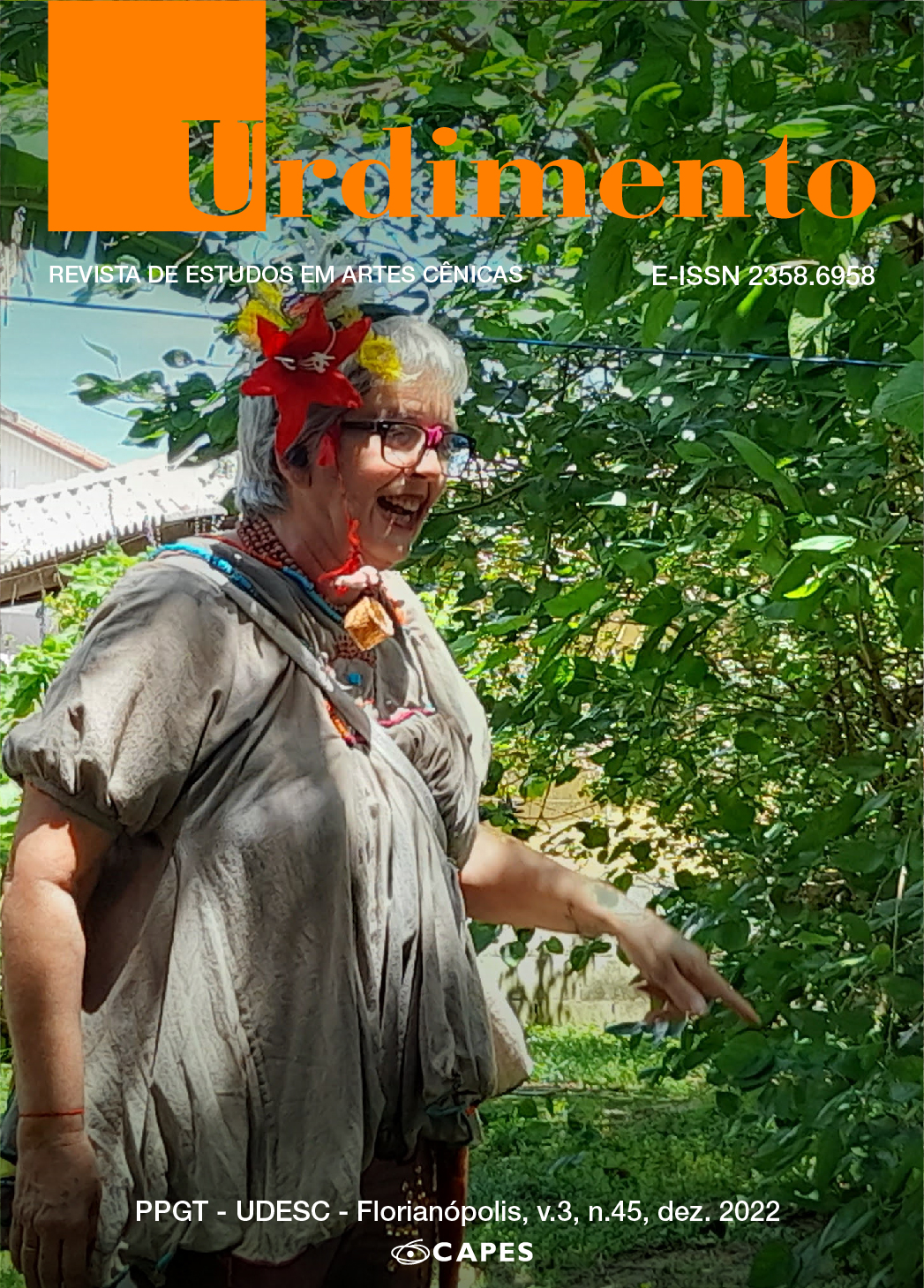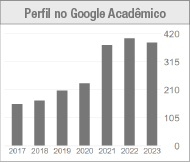Anjo Negro by Nelson Rodrigues: the characterization of the character Ismael
DOI:
https://doi.org/10.5965/1414573103452022e0203Keywords:
Anjo Negro, Racial Issue, Brazilian TheaterAbstract
This paper aims to reflect on the characterization of the character Ismael, in the play Anjo Negro, by Nelson Rodrigues. More specifically, the analysis seeks to demonstrate that Ismael, throughout the play, is constructed – by his words and actions, as well as by the information that the other characters present about him – as a “black angel”; image that evokes negative meanings, such as evil, cruelty and death. Such representation is constructed, mainly, in contrast to the image of Elias, a character who, in most acts, especially for the character Virgínia, reflects kindness, purity and delicacy, and whose physical appearance alludes to the figure of a common angel in the Christian imagination.
Downloads
References
BRANDÃO, Roberto. Sobre “Anjo Negro”. Diário Carioca. Rio de Janeiro, 06064 ed., p. 7. Disponível em: http://memoria.bn.br/DocReader/093092_03/32099.
Acesso em: 20 fev. 2022.
CAMARGO, Hertz Wendel de; HAIDA, Nathalia Akemi Lara; KÜHL, Crystian Eduard. A pós-vida do Mito: consumo e encruzilhadas do Diabo Na série Lúcifer. Travessias, Cascavel, v. 14, n. 1, p. 105–120, 2020. DOI: 10.48075/rt.v14i1.24172. Disponível em: https://e-revista.unioeste.br/index.php/travessias/article/view/24172. Acesso em: 20 fev. 2022.
CANDIDO, Antonio. Literatura e Sociedade. Rio de Janeiro: Ouro sobre Azul, 2006.
CHEVALIER, Jean; GHEERBRANT, Alain. Dicionário de Símbolos: mitos, sonhos, costumes, gestos, formas, figuras, cores, números. Trad. Vera da Costa e Silva et al. 16 ed. Rio de Janeiro: José Olympio, 2001.
FANON, Fantz. Pele Negra, Máscaras Brancas. Trad. Renato da Silveira. Salvador: Editora da Universidade Federal da Bahia, 2008.
FERRAZ, Selma. Os marginais na bíblia: Lúcifer e Madalena. Revista Estação Literária. V. 12, p. 143-164, 2014. Disponível em: https://www.uel.br/revistas/uel/index.php/estacaoliteraria/article/view/26213.
Acesso em: 20 fev. 2022.
HEDIONDO. In: MICHAELIS. Dicionário Brasileiro da Língua Portuguesa. São Paulo: Editora Melhoramentos, 2022. Disponível em: https://michaelis.uol.com.br/busca?id=dEE7#:~:text=2%20Que%20%C3%A9%20considerado%20desprez%C3%ADvel,Que%20%C3%A9%20f%C3%A9tido%20ou%20fedorento.
Acesso em: 20 fev. 2022.
LEAL, Maria Lucia. Anjo Negro: sexo e raça no teatro brasileiro. Urdimento - Revista de Estudos em Artes Cênicas, Florianópolis, v. 1, n. 16, p. 067-075, 2020.
DOI: 10.5965/1414573101162011067. Acesso em: 4 maio. 2022.
MAGALDI, Sábato. Teatro da Obsessão: Nelson Rodrigues. Global Editora: São Paulo, 2004.
MAGALHÃES, Antonio Carlos de Melo; BRANDÃO, Eli. O Diabo na arte e no imaginário ocidental. In: MAGALHÃES, Antonio Carlos de Melo et al. (org.). O demoníaco na literatura [online]. Campina Grande: EDUEPB, 2012. p. 277-290. Disponível em: https://static.scielo.org/scielobooks/y742k/pdf/magalhaes-9788578791889.pdf. Acesso em: 20 fev. 2022.
MAGNO, Paschoal Carlos. O “Anjo Negro” virá? Correio da Manhã, Rio de Janeiro, 16350 ed., p. 23, 1948a. Disponível em:
: http://memoria.bn.br/DocReader/089842_05/40278. Acesso em: 20 fev. 2022.
MAGNO, Paschoal Carlos. “Anjo Negro”, a Cendura e os escritores do Brasil. Correio da Manhã, Rio de Janeiro, 16351 ed., p. 13, 1948b. Disponível em: http://memoria.bn.br/DocReader/089842_05/40278. Acesso em: 20 fev. 2022.
MAGNO, Paschoal Carlos. A peça mais discutida do Brasil – Anjo Negro – Estreia hoje, no Fênix. Correio da Manhã, Rio de Janeiro, 16882 ed., p. 11, 1948c. Disponível em: http://memoria.bn.br/DocReader/089842_05/40816. Acesso em: 20 fev. 2022.
MAGNO, Paschoal Carlos. “Anjo Negro”, no Fênix. Correio da Manhã. Rio de Janeiro, 16885 ed., p. 15, 1948d. Disponível em:
http://memoria.bn.br/DocReader/089842_05/40880. Acesso em: 20 fev. 2022.
MEDEIROS, Elen de. A concepção do trágico na obra dramática de Nelson Rodrigues. 2010. Tese (Doutorado em Letras) - Instituto de Estudos da Linguagem – Unicamp, Campinas, 2010. Disponível em:
http://www.santoandre.sp.gov.br/pesquisa/ebooks/343671.PDF. Acesso em: 20 fev. 2022.
MILTON, J. O paraíso perdido. Trad. António José de Lima Leitão. São Paulo: Poeteiro Editor Digital, 2014.
NASCIMENTO, Robéria Nádia Araújo; PIRES, Valtyennya Campos. Paródias do “Senhor das Trevas”: Reinvenções simbólicas e arquetípicas da série Lúcifer. Revista Tropos: Comunicação, Sociedade e Cultura, v.9, nº1, 2020. Disponível em: https//revistas.ufac.br/index.php/tropos/article/view/2785. Acesso em: 20 fev. 2022.
NETO, Antônio Accioly. Finalmente o “Anjo Negro”. O Cruzeiro. Rio de Janeiro, 0008 ed., p. 49, 1947. Disponível em: http://memoria.bn.br/DocReader/003581/52254. Acesso em: 20 fev. 2022.
NETO, Antônio Accioly. Anjo Negro – Verso e reverso. O Cruzeiro. Rio de Janeiro, 0027 ed., p. 25, 1948. Disponível em: http://memoria.bn.br/DocReader/003581/58564. Acesso em: 20 fev. 2022.
PALLOTTINI, Renata. Dramaturgia: A construção do personagem. São Paulo: Ática, 1989.
PRADO, Décio de Almeida. O teatro brasileiro moderno. 2. ed. São Paulo: Perspectiva, 2001.
RODRIGUES, Nelson. Teatro completo: peças míticas. vol. 2. Rio de Janeiro: Nova Fronteira, 1981
SOUZA, Laura de Mello e. O diabo e a Terra de Santa Cruz: feitiçaria e religiosidade popular no Brasil Colonial. São Paulo: Companhia das Letras, 1986.
Published
How to Cite
Issue
Section
License
Copyright (c) 2022 Urdimento - Revista de Estudos em Artes Cênicas

This work is licensed under a Creative Commons Attribution 4.0 International License.
Copyright Statement
The articles published by the magazine are free to use. The copyright is all assigned to the magazine. The articles whose authors are identified represent the expression from the point of view of their authors and not the official position of the journal Urdimento. The author (s) undertakes whenever publishing material relating to the article published in Revista Urdimento mention the said publication as follows: This article was originally published by Urdimento magazine in its volume (put the volume), number (put the number) in the year of (put the year) and can be accessed at:
http://www.revistas.udesc.br/index.php/urdimento
This work is licensed under a Creative Commons Attribution 4.0 International License.




